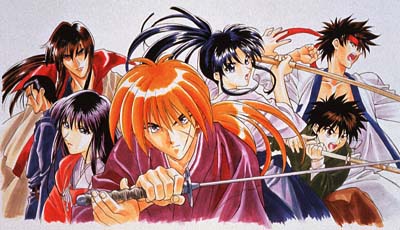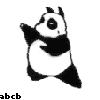
Understanding Taoism And Martial Arts With The Cast of Rurouni Kenshin
Now, if you're anything like me, when someone says "Martial Arts", you immediately think of giant, muscle-bound karate champions fighting for justice by beating up hundreds and hundreds of bad guys at a time. Or maybe ninjas.
And if someone should be unlucky enough to say "I am a martial artist", you will most likely smile politiely, head towards to punch bowl, and immediately leave the building, convinced ninjas just might drop from the ceiling at any time to attempt to assasinate that someone.
But the Taoists saw martial arts as something far more important than a simple means of defense (or a possible ticket to big bucks in the World Wrestling Federation). They saw them as a gateway ot the spiritual world.
Taoists had been training in martial arts for hundreds of years before the West even knew such a thing existed, and are responsible for maintaining many different styles which would otherwise be lost to us in this modern age. They saw martial arts not only as a way to protect their homes and monasteries (although this came in very handy...someone or another was always trying to sneak into Taoist temples, either to rob, to kill, or just find out secrets. People stupid enough to try this quite often did not make it out in one piece, if at all). They saw them as means of regulating breathing, physical exercise, a bridge to philisophical inquiry, and a preparation for meditation.
Taoist martial arts are often very different from other styles of martial arts, like Kung Fu and Tae Kwan Do, because they reflect not only simple defense and attack but complex philisophical concepts as well. You see, there are "hard" martial arts, like--
(All of a sudden a yell escapes from the street below.)
Err-- it seems something's happening down there. Let's just take a peek....
(Sanosuke stands in the street, facing a generally ill tempered individual. A small crowd has gathered around them.)
"Didn't your Mommy ever teach you not to steal, punk? I've got an itch to kick your ass."
"Oh yeah? I've heard of you! Sanza, the Gangster, right? Ha! Let's see what everyone thinks of you when I'm done beating you to a bloody pulp!"
(The unsavory individual flings himself at Sanosuke head on; Sanosuke replies by sending three punches into the man's chest, two quick kicks into his head, and a roundhouse punch into his face. The man skids to a stop about fifteen feet away and the crowd cheers.)
Well. That certainly was....violent.
But then again, that expertly shows what Hard martial arts are: Punches, kicks, and hard, solid moves. And while the Taoists developed their fair share of these styles , the most indicative Taoist styles are "Soft" Martial Arts. These styles don't use so much brute force as speed, agility, and "give-and-go" movements.
To explain the theory behind these styles (which may seem horribly inferior, at first), let's examine this old Taoist image: A Strong Man swatting at a sapling tree.
The strong man hits and punches and kicks with all his might, but the tree just bends back and forth. If he ever does manage to connect, the tree just bends, then whips back and smacks his palm. The harder he punches, the more it bends, and the harder it strikes his palm. Eventually, the strong man (if he has the brains of a cabbage) just gives up and walks away.
Soft martial arts teach you to be like the tree; to give and redirect, not oppose with brute force. These styles could be devestating, and many of the world's greatest martial champions would never be able to lay even a finger on a Taoist master.
Taoist martial arts are often centered around giving and redirecting, without direct retaliation; however, when they do utilize attacks, the aim is often to wound without killing. Taoists did not believe in unecessary violence, and if a student could not win a duel without killing an opponent, that was considered a weakness.
Perhaps one of the best examples of this is our friend Kenshin's Sakaba Sword. A Sakaba sword is a sword with the blade on the the wrong side, so the dull (and non-lethal) side is facing out. Kenshin uses this so that he can sword fight without killing his opponents.
Quite a few characters in Rurouni Kenshin have taken time to mock Kenshin's sword. Quite a few of those same people later got their butts kicked all over the floor by the Sakaba sword. The point is that martial arts don't have to be lethal to be strong, as Kenshin demonstrates. The Taoists knew this, and they harnessed this strength to create some of the most dangerous (and beautiful) martial arts known to man.
Perhaps the most popular Taoist martial art is Tai Chi Chuan. Tai Chi is noteable because it is performed incredibly slowly, almost like a dance. The movements are calculated and graceful, but hidden in each step lies a potent defensive posture. Used as a tool to calm the mind  and slow the breathing, Tai Chi has numerous health benefits for both the long time practitioner and the newcomer (in fact, if you observe the opening song from the Ranma 1/2 television series, Ranma, Genma, and Akane are performing moves from Tai Chi Chuan. To the right is a gif animation of Genma doing just that). For reference purposes, I will be mostly referring to the Yang Family style of tai Chi Chuan, which is the most common form and the form officially sanctioned by the government of China.
But Tai Chi is more than simply good exercise. In every move, it embodies the teachings of Taoist Philosophy. For example:
and slow the breathing, Tai Chi has numerous health benefits for both the long time practitioner and the newcomer (in fact, if you observe the opening song from the Ranma 1/2 television series, Ranma, Genma, and Akane are performing moves from Tai Chi Chuan. To the right is a gif animation of Genma doing just that). For reference purposes, I will be mostly referring to the Yang Family style of tai Chi Chuan, which is the most common form and the form officially sanctioned by the government of China.
But Tai Chi is more than simply good exercise. In every move, it embodies the teachings of Taoist Philosophy. For example:
In each stance, one leg is empty, or has no weight, and one leg is full, or most of the weight. This is demonstrating Yin and Yang.
In the movement "Grasp The Swallows Tail", you do not block the arm, you pull it. This is giving in and redirecting.
Each movement is slow, never hurrying. This is the Taoist belief in observing the world's pace and never hurrying. In different forms of Tai Chi, the slow movements are interspersed with fast movements; this is Yin and Yang.
The list goes on. The practice of martial arts has numerous physical benefits, but the Taoists added spiritual benefits by incorporating their philosophy as well. By practicing these arts, you can gain a firmer grasp on concepts that may seem foreign to you, as well as get in shape and defend yourself.
And you don't have to be Chuck Norris to do it, either. :-)

Take me Back To The Lessons Index!


 and slow the breathing, Tai Chi has numerous health benefits for both the long time practitioner and the newcomer (in fact, if you observe the opening song from the Ranma 1/2 television series, Ranma, Genma, and Akane are performing moves from Tai Chi Chuan. To the right is a gif animation of Genma doing just that). For reference purposes, I will be mostly referring to the Yang Family style of tai Chi Chuan, which is the most common form and the form officially sanctioned by the government of China.
But Tai Chi is more than simply good exercise. In every move, it embodies the teachings of Taoist Philosophy. For example:
and slow the breathing, Tai Chi has numerous health benefits for both the long time practitioner and the newcomer (in fact, if you observe the opening song from the Ranma 1/2 television series, Ranma, Genma, and Akane are performing moves from Tai Chi Chuan. To the right is a gif animation of Genma doing just that). For reference purposes, I will be mostly referring to the Yang Family style of tai Chi Chuan, which is the most common form and the form officially sanctioned by the government of China.
But Tai Chi is more than simply good exercise. In every move, it embodies the teachings of Taoist Philosophy. For example: